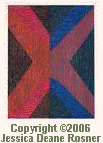Post appears BELOW Table of Contents.
This blog focuses on similarities between others' four-folds, tetrads, tetrachotomies, and mine, and includes links to online information on others’ fours in their own terms. It results from overgrowth of an old post at The Tetrast "What of these other fours?".|
Table of Contents Fours that I've adopted or adapted:
Fours with a striking likeness to mine: Fours involving some likeness to mine: |
More-or-less different fours:
|
Unless otherwise stated within the post, first posted on Friday, December 5, 2008. Post times here are just a device to control the order of appearance. Most of the posts are based on entries in an older post "What of These Other Fours?" at The Tetrast.
Walker Percy's semiotic tetrad
Walker Percy's tetrad of Symbol (or sign), Object, Organism1 (I), and Organism2 (Thou). Symbol and Object comprise a relation of quasi-identity or meaning. Organism1 (I), and Organism2 (Thou) comprise a relation of intersubjectivity. The two relations are sometimes shown intersecting across a diamond-shaped diagram.
Walker Percy jumbles functionally-defined semiotic elements with their bearers, sets up an ungainly tetrad of two organisms (I and Thou) and two things (object and symbol)), and that tetrad does not lend itself to generalization in terms of correlations to philosophical categories. Percy’s tetrad does not strike me as really philosophical.
Irrespectively, there might be some correlation with my foursomes, a correlation to that extent to which one may interpret one of the Organisms as the interpretant and the other Organism as the collaterally based recognition (which I call the "recognizant" or the "establishment"), or perhaps each of the Organisms as an interpretant and their supportings, checkings, & balancings of each other (in regard to symbol and object) as the recognizant — but these semiotic functions should be embodied by separate dedicated terms in the tetrad just as object and symbol are. And to some extent a single cognizant organism or at any rate a mind acts as its own cognitive support, check, & balance, even though it has learned much of how to do so from collaboration, strife, etc., with other organisms. (The recognizant is the verificatory/disconfirmatory element whereby I augment the Peircean triad to a tetrad). However, I wouldn’t tie interpretant and recognizant to being the fundamental semiotic “I” and “Thou” in whatever order (I would hold that the semiotic object is addressed to its sign, the sign to its interpretant, and the interpretant to its recognizant. I've discussed semiotics in “Semiotic triad versus tetrad”, also in “Why Tetrastic?” under “Semiotics” and in “Semiotics: collaterally based recognition, the proxy, and counting-as.”)
| Organism1 (I) | ||||
| S y m b o l | R e l a t i o n of | O b j e c t | ||
| Relation of | Quasi- Identity (Meaning) | |||
I n t e r s u b j e c t i v i t y | ||||
| Organism2 (Thou) | ||||
Walker Percy jumbles functionally-defined semiotic elements with their bearers, sets up an ungainly tetrad of two organisms (I and Thou) and two things (object and symbol)), and that tetrad does not lend itself to generalization in terms of correlations to philosophical categories. Percy’s tetrad does not strike me as really philosophical.
Irrespectively, there might be some correlation with my foursomes, a correlation to that extent to which one may interpret one of the Organisms as the interpretant and the other Organism as the collaterally based recognition (which I call the "recognizant" or the "establishment"), or perhaps each of the Organisms as an interpretant and their supportings, checkings, & balancings of each other (in regard to symbol and object) as the recognizant — but these semiotic functions should be embodied by separate dedicated terms in the tetrad just as object and symbol are. And to some extent a single cognizant organism or at any rate a mind acts as its own cognitive support, check, & balance, even though it has learned much of how to do so from collaboration, strife, etc., with other organisms. (The recognizant is the verificatory/disconfirmatory element whereby I augment the Peircean triad to a tetrad). However, I wouldn’t tie interpretant and recognizant to being the fundamental semiotic “I” and “Thou” in whatever order (I would hold that the semiotic object is addressed to its sign, the sign to its interpretant, and the interpretant to its recognizant. I've discussed semiotics in “Semiotic triad versus tetrad”, also in “Why Tetrastic?” under “Semiotics” and in “Semiotics: collaterally based recognition, the proxy, and counting-as.”)
. . . . |


